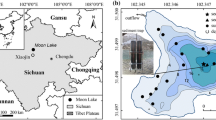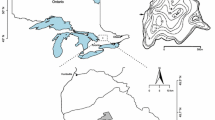Abstract
Remains of Cladocera were examined in short sediment cores from three Adirondack lakes with mean pHs below 5 and a fourth with a mean pH of 6.5. These cores were collected as part of the Paleoecological Investigation of Recent Lake Acidification (PIRLA I) project. Historical and paleolimnological evidence suggests that pH has decreased in each of the acid lakes in recent decades. In all of the study cores, the greatest changes in net accumulation rates, assemblage composition, and species richness occurred in recently deposited sediments. The similar timing of events in all lakes suggests that a regional disturbance was responsible. In the three acid lakes, there was a strong association of changes in cladoceran assemblages and diatom, chrysophyte, and geochemical evidence of acidification. The occurrence of recent changes in non-acid Windfall Pond indicates that other factors may also have affected Cladocera in the study lakes.
Similar content being viewed by others
References
Anderson, N. J., 1989. A whole-basin diatom accumulation rate for a small eutrophic lake in Northern Ireland and its palaeoecological implications. J. Ecol. 77: 926–946.
Appelberg, M., B. Henrikson, L. Henrikson & M. Svedang, 1993. Biotic interactions within the littoral community of Swedish forest lakes during acidification. Ambio 22: 290–297.
Altshuller, A. P. & R. A. Linthurst (eds), 1984. The acidic deposition phenomenon and its effects: Critical assessment and review papers. EPA-600/8-3/01BF. U.S. Environmental Protection Agency, Washington, D.C.
Arzet, K., D. Krause-Dellin & C. Steinberg, 1986. Acidification of four lakes in the Federal Republic of Germany as reflected by diatom assemblages, cladoceran remains, and sediment chemistry. In J. P. Smol, R. W. Batterbee, R. W. Davis, and J. Meriläinen (eds), Diatoms and Lake Acidity. Dr. W. Junk, Dordrecht, Netherlands: 227–250.
Binford, M. W., 1983. Ecological correlates of net accumulation rates of Cladocera remains in lake sediments.Hydrobiologia 143: 123–128.
Binford, M. W., 1990. Calculation and uncertainty analysis of210Pb dates for PIRLA project lake sediment cores. J. Paleolim. 3: 253–267.
Binford, M. W., J. S. Kahl & S. A. Norton, 1993. Interpretation of210Pb profiles and verification of the CRS dating model in PIRLA project lake sediment cores. J. Paleolim. 9: 275–296.
Brakke, D. F., 1980. Atmospheric deposition in Norway during the last 300 years as recorded in SNSF lake sediments. III. Cladoceran community structure and stratigraphy. In D. Drabløs and A. Tollan (eds), Ecological impact of acid precipitation. SNSF project, Oslo, Norway: 272–273.
Brakke, D. F., R. B. Davis & K. H. Kenlan, 1984. Acidification and changes over time in the chydorid cladocera assemblage of New England lakes. In G. R. Hendrey (ed.), Early biotic responses to advancing lake acidification. Butterworth, Boston (MA): 85–104.
Brett, M. T., 1989. Zooplankton communities and acidification processes (a review). Wat. Air Soil Pollut. 44: 387–414.
Brezonik, P. L., J. G. Eaton, T. M. Frost, P. J. Garrison, T. K. Kratz, C. E. Mach, J. H. McCormick, J. A. Perry, W. A. Rose, C. J. Sampson, B. C. L. Shelly, W. A. Swenson & K. E. Webster, 1993. Experimental acidification of Little Rock Lake, Wisconsin: chemical and biological changes over the pH range 6.1 to 4.7. Can. J. Fish. aquat. Sci. 50: 1101–1121.
Charles, D. F. & S. A. Norton, 1986. Paleolimnological evidence for trends in atmospheric deposition of acids and metals. Acid deposition: long-term trends. National Academy Press, Washington, D.C.: 335–435.
Charles, D. F. & J. P. Smol, 1988. New methods for using diatoms and chrysophytes to infer past pH of low-alkalinity lakes. Limnol. Oceanogr. 33: 1451–1462.
Charles, D. F. & D. R. Whitehead, 1986a. The PIRLA project: Paleoecological investigations of recent lake acidification. Hydrobiologia 143: 13–20.
Charles, D. F. & D. R. Whitehead (eds), 1986b. Paleoecological investigation of recent lake acidification: methods and project description. EA-4906 Research Project 2174-10, Electric Power Research Institute, Palo Alto, CA.
Charles, D. F., M. W. Binford, E. T. Furlong, R. A. Hites, M. J. Mitchell, S. A. Norton, F. Oldfield, M. J. Paterson, J. P. Smol, A. J. Uutala, J. R. White, D. R. Whitehead & R. J. Wise, 1990. Paleoecological investigation of recent lake acidification in the Adirondack Mountains, N. Y. J. Paleolim. 3: 195–241.
Charles, D. F., D. R. Whitehead, D. S. Anderson, R. Bienert, K. E. Camburn, R. B. Cook, T. L. Crisman, R. B. Davis, J. Ford, B. D. Fry, R. A. Hites, J. S. Kahl, J. C. Kingston, R. G. Kreis Jr., M. J. Mitchell, S. A. Norton, L. A. Roll, J. P. Smol, P. R. Sweets, A. J. Uutala, J. R. White, M. C. Whiting & R. J. Wise, 1986. The PIRLA project (Paleoecological Investigation of Recent Lake Acidification): Preliminary results for the Adirondacks, New England, N. Great Lakes states, and N. Florida. Wat. Air Soil Pollut. 30: 355–365.
Collins, N. C., A. P. Zimmerman & R. Knoechel, 1981, Comparisons of benthic infauna and epifauna biomasses in acidified and non-acidified Ontario lakes. In R. Singer (ed.), Effects of Acid Precipitation on Benthos. North American Benthological Society, Hamilton (N.Y.): 35–48.
Confer, J. L., T. Kaaret & G. E. Likens, 1983. Zooplankton diversity and biomass in recently acidified lakes. Can. J. Fish. aquat. Sci. 40: 36–42.
Dixit, S. S., J. P. Smol, J. C. Kingston & D. F. Charles, 1992. Diatoms: powerful indicators of environmental change. Envir. Sci. Technol. 26: 23–33.
France, R. L. & P. M. Welbourn, 1992. Influence of lake pH and macrograzers on the distribution and abundance of nuisance metaphytic algae in Ontario, Canada. Can. J. Fish. aquat. Sci. 49: 185–195.
Goulden, C. E., 1964. The history of the cladoceran fauna of Esthwaite Water (England) and its limnological significance. Arch. Hydrobiol. 60: 1–52.
Goulden, C. E., 1969. Interpretative studies of cladoceran microfossils in lake sediments. Mitt. int. Ver. Limnol. 17: 43–55.
Goulden, C. E. & G. Vostreys, 1985. Animal microfossils. In G. E. Likens (ed.), An Ecosystem Approach to Aquatic Ecology. Mirror Lake and its Environment. Springer-Verlag, New York (N.Y.): 382–386.
Hann, B. J., 1981. Occurrence and distribution of littoral Chydoridae (Crustacea, Cladocera) in Ontario, Canada, and taxonomic notes on some species. Can. J. Zool. 59: 1465–1474.
Hann, B. J., 1989. Methods in quaternary ecology #6. Cladocera. Geoscience Canada 16: 17–26.
Hansen, J. & S. Lebedeff, 1987. Global trends of measured surface air temperature. J. Geophys. Res. 92: 13345–13372.
Havas, M., 1985. Aluminum accumulation and toxicity toDaphnia magna in soft water at low pH. Can. J. Fish. aquat. Sci. 42: 1741–1748.
Havens, K. E. & J. DeCosta. 1987. The role of aluminum contamination in determining phytoplankton and zooplankton responses to acidification. Wat. Air Soil Pollut. 33: 277–293.
Havens, K. E., 1991. Littoral zooplankton responses to acid and aluminum stress during short-term laboratory bioassays. Envir. Pollut. 73: 71–84.
Havens, K. E., 1992. Acid and aluminum effects on sodium home-ostasis and survival of acid-sensitive and acid-tolerant Cladocera. Can. J. Fish. aquat. Sci. 49: 2392–2398.
Jackson, S. T. & D. F. Charles, 1988. Aquatic macrophytes in Adirondack (New York) lakes: patterns of species composition in relation to environment. Can. J. Bot. 66: 1449–1460.
Ketchledge, E. H., 1965. Changes in the forests of New York. The N.Y. State Conservationist (February–March).
Kingston, J. C. & H. J. B. Birks, 1990. Dissolved organic carbon reconstructions from diatom assemblages in PIRLA project lakes, North America. Phil. Trans. r. Soc., Lond. B 327: 279–288.
Kingston, J. C., H. J. B. Birks, A. J. Uutala, B. F. Cumming & J. P. Smol, 1992. Assessing trends in fishery resources and lake water aluminum from paleolimnological analyses of siliceous algae. Can. J. Fish. aquat. Sci. 49: 116–127.
Locke, A., 1991. Zooplankton responses to acidification: a review of laboratory bioassays. Wat. Air Soil Pollut. 60: 135–148.
Marmorek, D. R. & J. Korman, 1993. The use of zooplankton in a biomonitoring program to detect lake acidification and recovery. Wat. Air Soil Pollut. 69: 223–241.
Nilssen, J. P. & S. Sandøy, 1990. Recent lake acidification and cladoceran dynamics: surface sediment and core analyses from lakes in Norway, Scotland and Sweden. Phil. Trans. r. Soc., Lond. B 327: 299–309.
Norton, S. A., R. W. Bienert, M. W. Binford & J. S. Kahl, 1992. Stratigraphy of total metals in PIRLA sediment cores. J. Paleolim. 7: 191–214.
Nyberg, P., 1984. Impact ofChaoborus: predation on planktonic crustacean communities in some acidified and limed forest lakes in Sweden. Rep. Inst. Freshw. Res. Drottingholm 61: 155–166.
Paterson, M. J., 1985. Paleolimnological reconstruction of cladoceran response to presumed acidification of four lakes in the Adirondack Mountains (New York). M.A. thesis, Indiana Univ., Bloomington, Indiana, 200 pp.
Rudd, J. W. M. (ed.), 1987. Acification of the Moose River system in the Adirondack Mountains of New York state. Biogeochemistry 3: 1–296.
Schofield, C. L. & C. T. Driscoll, 1987. Fish species distribution in relation to water quality gradients in the North Branch of the Moose River Basin. Biogeochemistry 3: 63–85.
Smol, J. P., 1981. Problems associated with the use of ‘species diversity’ in paleolimnological studies. Quat. Res. 15: 209–212.
Smol, J. P. & S. S. Dixit, 1990. Patterns of pH change inferred from chrysophyte microfossils in Adirondack and northern New England lakes. J. Paleolim. 4: 31–41.
Smol, J. P., D. F. Charles & D. R. Whitehead, 1984. Mallomonadacean microfossils provide evidence of recent lake acidification. Nature 307: 628–630.
Steinberg, C., H. Hartmann, K. Arzet & D. Krause-Dellin, 1988. Paleoindication of acidification in Kleiner Arbersee (Federal Republic of Germany, Bavarian Forest) by chydorids, chrysophytes, and diatoms. J. Paleolim. 1: 149–157.
Sutherland, J. W., S. O. Quinn, J. A. Bloomfield & C. A. Siegfreid, 1983. Lake acidification and the biology of Adirondack lakes: crustacean zooplankton communities. Lake and Reservoir Management. EPA 440/5/84-001: 380–384.
ter Braak, C. J. F., 1992. CANOCO — a FORTRAN program for Canonical Community Ordination. Microcomputer Power, Ithaca, New York (N.Y.), 95 pp.
Uimonen-Simola, P. & K. Tolonen, 1987. Effects of recent lake acidification on Cladocera in small clear water lakes studied by means of sedimentary remains. Hydrobiologia 145: 343–351.
Uutala, A. J., 1986. Paleolimnological assessment of the effects of lake acidification on Chironomidae (Diptera) assemblages in the Adirondack region of New York. Ph.D. Thesis, St. Univ. NY Coll. Envir. Sci. For., Syracuse, 156 pp.
Uutala, A. J., 1990.Chaoborus (Diptera: Chaoboridae) mandibles — paleolimnological indicators of the historical status of fish populations in acid-sensitive lakes. J. Paleolim. 4: 139–151.
Wood, R. B., T. E. Andrew & J. M. Redfern, 1990. Cladoceran remains from the most recent sediments of Lough Neagh, northern Ireland. Verh. int. Ver. Limnol. 24: 560–562.
Yan, N. D., C. J. LaFrance & G. G. Hitchin, 1982. Planktonic fluctuations in a fertilized, acidic lake: the role of invertebrate predators. In R. E. Johnson (ed.), Acid Rain/Fisheries. American Fisheries Society, Bethesda (MD.): 137–154.
Author information
Authors and Affiliations
Additional information
This is the fifteenth of a series of papers to be published by this journal which is a contribution of the Paleoecological Investigation of Recent Lake Acidification (PIRLA) project. Drs. D. F. Charles and D. R. Whitehead are guest editors for this series.
Rights and permissions
About this article
Cite this article
Paterson, M.J. Paleolimnological reconstruction of recent changes in assemblages of Cladocera from acidified lakes in the Adirondack Mountains (New York). J Paleolimnol 11, 189–200 (1994). https://doi.org/10.1007/BF00686865
Received:
Accepted:
Issue Date:
DOI: https://doi.org/10.1007/BF00686865




